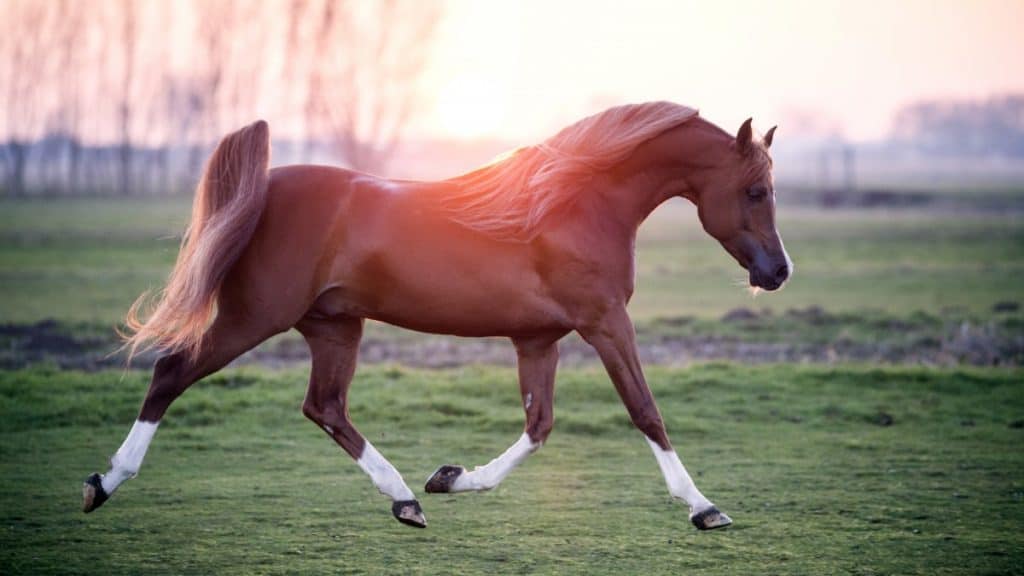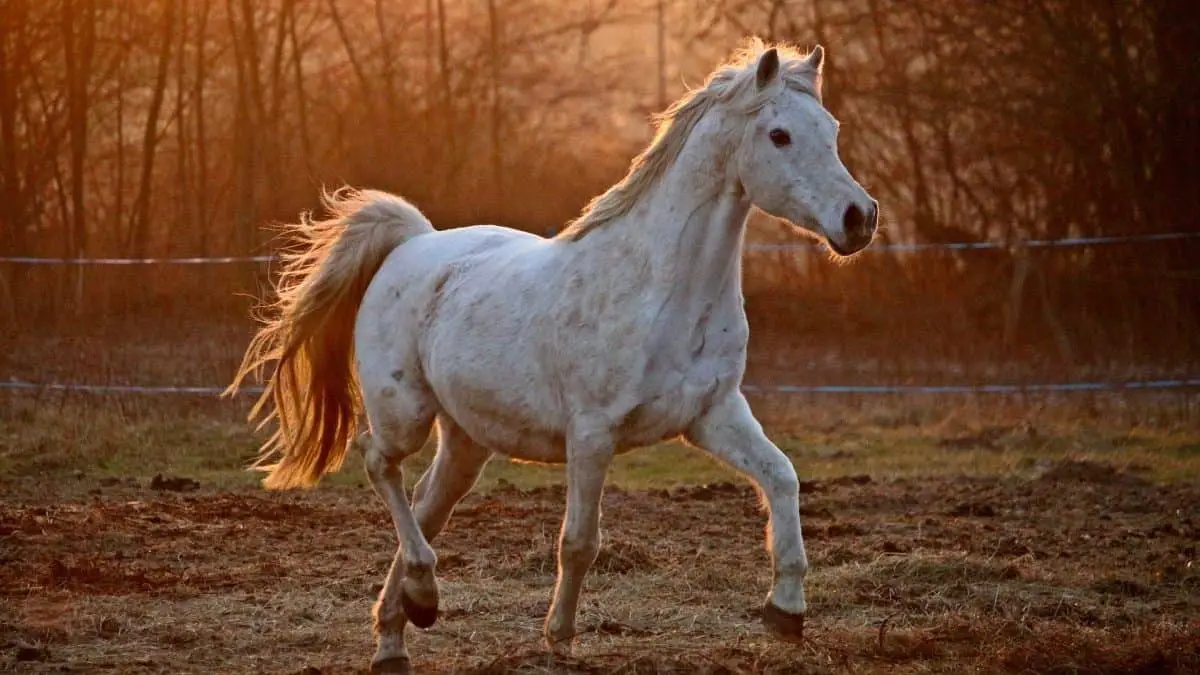Skip To Section
Horses come in a huge range of sizes. Breed, type, age, and other factors affect a horse’s weight in important ways. There are miniature horses 9 hands high (hh) like the Shetland pony that weighs only 200 kg, and there are huge 16 hh draught Shire horses that can weigh more than 850 kg.
How Heavy Is A Horse On Average?
Standard full-grown horses have a pretty wide range of weight averages. The range is between 380 – 907 kilograms (840 and 2,000 lbs).
Quarter horses range between 430 – 544 kg kilograms (950 and 1,200 lbs), and ponies range between 200 and 400 kilograms (440 – 880 lbs).

Average Horse Weight By Breed
The following table gives us a comparison of the weights of several different breeds. It is an average only. Some horses in these breeds will be larger, and others will be smaller.
| Height | Pony | Polo Pony | Arabian | Cob | TB | L/W Hunter | M/W Hunter | H/W Hunter | Draught |
| 9hh | 200kg | ||||||||
| 10hh | 200kg | ||||||||
| 12hh | 200kg | ||||||||
| 12.3hh | 300kg | ||||||||
| 13hh | 300kg | ||||||||
| 14hh | 300kg | 400kg | |||||||
| 14.1hh | 400kg | 400kg | |||||||
| 14.2hh | 400kg | 400kg | 400kg | 450kg | |||||
| 14.3hh | 450kg | 450kg | 500 kg | ||||||
| 15hh | 500kg | 450kg | 500 kg | 400kg | |||||
| 15.1hh | 500kg | 500kg | 500 kg | 400kg | 450kg | ||||
| 15.2hh | 450kg | 500kg | 500kg | ||||||
| 15.3hh | 500kg | 500kg | 550kg | 600kg | 700kg | ||||
| 16hh | 500kg | 550kg | 600kg | 650kg | 750kg | ||||
| 16.1hh | 550kg | 550kg | 600kg | 650kg | 800kg | ||||
| 16.2hh | 550kg | 550kg | 650kg | 650kg | 850kg | ||||
| 16.3hh | 600kg | 600kg | 650kg | 700kg | 850kg |
Pony
Most horse organizations have no weight standard to determine if a horse is classified as a pony or not, but there is a height cut-off. As you can see on the chart, a pony cannot be classified as such if it is higher than 14.2 hands. That’s 147cm (57.8″) or smaller.
Some breeds are considered ‘pony breeds’ based on height. Notice the Polo Pony, Arabian, and Cob all can fall into this category based on height.
Ponies are known for their heftier frame. They often carry a slightly higher weight to height ratio than other horses. But this is not always the case. Hackney ponies look almost identical in terms of weight/height ratio.
Typically, a pony’s average weight is 150 to 200 kg (330 – 440 lbs) for a standard Shetland. Heftier breeds like Haflinger can weigh between 363 and 590 kg (800 – 1300 lbs).
Polo Pony
Originally the rules stated that the polo pony was limited to 14.2 hands in height. But this is no longer the case. Some polo ponies are 15 or 16 hands today and can weigh between 400 and 500 kg (881 – 1102 lbs).
The genetic makeup of polo ponies is usually three-quarters Thoroughbred or more, giving them an excellent disposition (high stamina and speed) for the game.

Arabian
Arabian horses are the earliest example of an improved breed of horse, and equestrians have valued them since the 7th century. Their average height is about 15 hh (60″/152cm), and their weight range is between 360 to 450 kg (800 – 1,000 lbs).
Cob
The Cob is a horse type and not a breed, and they are generally smaller and more compact relative to other types. Traditionally the Cob was a draft pony. They are now popular for recreational riding, showing, and driving.
They can stand as little as 14.2 hh (58″/147 cm) and sometimes reach heights above 15.1 hh. Their average weight is between 450 and 500 kg (992 – 1102 lbs).
The Cob divides into three height/weight categories:
- Lightweight Cob: up to 14.2 hh
- Heavyweight Cob: over 14.2 hh but no more than 15.1 hh
- Maxi Cob: over 15.1 hh

Thoroughbred
Best known for their use in racing, thoroughbreds come in a variety of weight averages.
Track horses tend to be leaner and thinner. Thoroughbreds who are trail horses or who have careers in hanger/jumper rings tend to be heavier than track horses.
470 to 515 kg (1036 to 1135 lbs) is the average weight of a thoroughbred racehorse. Thoroughbreds are raced at a young age, usually around 2, and don’t become physically mature until the age of 5. At this point, they retire from racing and have an average weight of 570 kg (1256 lbs).
Hunters
The most common use of Show Hunters is as show horses at equestrian events. They divide into three weight categories: light, middle, and heavyweights.
- Lightweight Hunters stand around 16 to 16.2 hh and weigh between 450 and 600 kg (992 – 1322 lbs)
- Middleweight Hunters stand around 16.3 hh and weigh between 500 and 650 kg (1102 – 1433 lbs)
- Heavyweight Hunters stand around 17 hh and weigh between 600 and 700 kg (1322 – 1543 lbs)

Draught
Draught horses are working animals who used to be responsible for farm labor in pre-industrial times. Today draft breeds are considered versatile, and sometimes they are bred for both riding and showing.
Their size ranges from approximately 16 to 19 hh, and their weight ranges from 640 to 910 kg (1,400 to 2,000 lbs).
Factors That Influence A Horses Weight
The use and purpose of a horse will affect what is considered desirable and healthy in terms of weight. There are many different optimal weights depending on the type of horse and its height. Racing thoroughbreds, for example, might weigh between 400 – 600 kg (900 – 1,300 lbs) depending on the size of the breed.
Regardless of breed, a horse’s weight must stay within a healthy bracket. An unhealthy weight can cause serious health issues. An underweight horse can indicate health issues or insufficient feeding, so understanding what is appropriate in terms of diet for your horse is vital for their good health. Age can also play a factor. Weight loss is a common problem in older horses.
Many health issues and diseases that affect horses are likely to affect their feeding and average weight. This can include the following:
- Dental problems
- Obstructions of the throat
- Internal parasites (which causes malabsorption/maldigestion)
- Inflammatory Bowel Disease
You should always consult your veterinarian for advice on weight loss symptoms, and dental checkups should be a regular feature of their health regime. A structured worming plan is also a must to maintain a healthy weight in your horse.
Knowing a horse’s weight is particularly important for good doers. These are horses or ponies that can maintain a healthy weight on minimal food or insufficient quality grazing grounds. Because many of these horses now no longer live as they used to when they evolved their grazing habits, it is important to watch their weight. Good doers can be prone to obesity, metabolic problems, and laminitis.
What Is A Body Condition Score (BCS)?
Body Condition Scoring is a way to evolute your horse’s body condition (stored fat). BCS is not difficult to measure. A good rule of thumb to follow is to run your hand over their ribcage. You should be able to feel the ribs easily but not see them.
If a horse is overweight, it will exhibit some of the following features:
- ‘Cresty’ neck
- Soft, bulging area around the trailhead
- Fat bulging behind shoulders/along inner buttocks
- Ribs will be hard to feel
- Rounded whithers/shoulder blades hard to see
- Crease down the center of the horses back
How Do You Make Horse Weight Calculations?
As we mentioned above, knowing how much your horse weighs is an integral part of their care. It’s not just used to calculate their feeding and general health tracking, but also their medications and deworming programs.
There are few methods used to determine a horse’s weight. One is to use equine scales, which you can find at equine clinics and hospitals. These are large scales that the horse can step onto, and they give an accurate reading of the horse’s body weight.
If you don’t have a scale, there are other ways to estimate your horse’s weight with some accuracy. You’ll need a measuring tape and two people.
Step 1
Make sure the horse is standing square. Measure from the shoulder point to the buttocks. This measures the length.
Step 2
Begin measuring from the top of the whithers going around the horse behind the front leg and back to where you started. Make sure the circumference line is straight.
Step 3
Make the following calculations: (Heart Girth x Heart Girth x Body Length) / 330* = Horses Weight in Pounds
* Change the number you divide by based on their age:
- Mature: 330 lbs
- Yearling: 301 lbs
- Weanling: 280 lbs
- Pony: 299 lbs
How Do You Use A Weight Tape?
Above we looked at how to make weight calculations of a horse with a standard tape measure, but there is another way to do it.
Weight tapes are specialized tape measurers that have length measurements beside weight estimates. Although not 100% accurate, a weight tape will help you get an approximate weight of your horse by measuring only its heart girth in the same way we discussed above.
Weight tapes are handy if your horse is carrying some extra weight. You’ll want to track his weight changes monthly to make sure he’s losing weight.
How Heavy Was The Heaviest Horse?
There are several horses on record as the heaviest and tallest horses. Sampson was a Shire draft horse born in 1846 who stood at 21.2 hands (86″/218 cm) and weighed around 1,526 kg (3,360 lbs).
Big Jake holds the current title for the tallest living horse at 20.3 hands (210.2 cm / 6’10-3/4″), and he weighs 1,133 kg (2,600 lbs). Big Jake is a Belgian draft.
